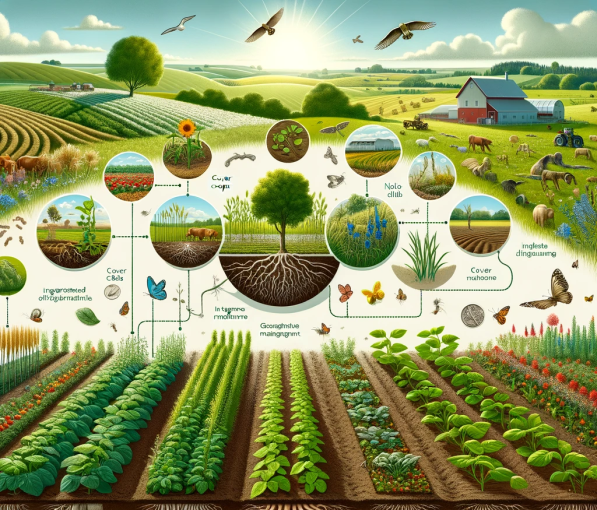Sustainability remains a focal point, with efforts to reduce greenhouse gas emissions gaining momentum. For instance, Arla Foods UK's trial of Bovaer, a dairy feed additive designed to cut methane emissions from cows by 30%, has sparked debate. Despite approvals from multiple food safety authorities, misinformation on social media has led to consumer boycotts, highlighting the challenges in balancing innovation with public perception.
Sustainable agriculture practices not only prioritize the health of our soil organisms and environment but also ensure that farming remains viable and prosperous in the long term. By embracing sustainable practices, we’re not just focusing on present food requirements. We’re also laying down a robust foundation for generations to come.
Sustainable Agriculture Practices offer a Myriad of Benefits:
- Preserving Soil Health: Sustainable farming practices like crop rotations, cover crops, and the incorporation of organic matter into the soil ensure it remains fertile and productive.
- Promoting Biodiversity: These practices create a harmonious environment where various crops and livestock can thrive. Agrobiodiversity ensures a balanced ecosystem, reducing the risks of diseases and pests.
- Securing Future Food Supply: With an ever-increasing global population, securing our food supply for future generations is critical. Sustainable farming systems focus on long-term productivity rather than just immediate yields.
- Supporting Farmer Livelihoods: The transition to sustainable practices often results in reduced input costs and better farm-gate prices, directly benefiting farmers’ economic well-being.
- Combatting Climate Change: Sustainable farms play a pivotal role in sequestering carbon, reducing greenhouse gas emissions, and countering the adverse effects of climate change.
Sustainable Farming Practices
- Crop Rotation and Diversification: This age-old practice involves growing different types of crops in a sequence on the same land. It breaks pest cycles and increases the soil moisture and fertility.
Example: After growing a nutrient-consuming crop like corn, a nitrogen-fixing legume like beans can be planted to restore the soil’s balance.
- Organic Farming: Prioritizing natural methods over synthetic inputs, organic farming is a holistic approach that emphasizes soil health, biodiversity, and ecological balance. Example: RegenX’s sustainable agriculture approach enables buyers to source ingredients free from synthetic chemicals, promoting a cleaner ecosystem
- Conservation Tillage:This practice minimizes soil disruption, reducing soil erosion and retaining water. It allows crop residues soil nutrients and organic matter to remain on fields. Example: No-till farming, a subset of conservation tillage, leaves previous crop residues untouched, fostering natural decomposition and enhancing soil quality.
- Agroforestry: Melding together agriculture, livestock production and forestry, agroforestry is a multifunctional system where trees or shrubs are grown around or among crops or pastureland. Plus, agroforestry aligns well with the EU deforestation regulation, ensuring that farming does not contribute to deforestation but instead plays a part in forest conservation.
- Cover Cropping:Growing specific crops not intended for harvest, protects the soil, improves soil health and fertility, and manages pests.Example: Planting clover during off-seasons, prevents soil erosion, suppresses weeds, and enriches the ground with essential nutrients.
- Permaculture: An integrated design philosophy that simulates patterns in nature, ensuring resources are used in a closed-loop system, minimizing waste.Example: Designing a garden where water from a fish pond is used to irrigate plants, and plant waste, in turn, feeds the fish.
- Aquaponics: A sustainable system combining conventional aquaculture with hydroponics, fish and plants grow together in one integrated environment.Example: Fish waste provides an organic nutrient source for plants, and the plants help filter and purify the water, which is then recirculated back to the fish tanks.
- Waste Recycling and Composting:Turning organic waste into valuable compost, this process enriches the soil, reduces the need for chemical fertilizers, and minimizes waste.Example: Using vegetable scraps, fallen leaves, and manure to create a rich compost heap that can be returned to the garden.
- Polyculture: Growing multiple crops in the same space simultaneously, this method maximizes land usage, reduces pest issues, and promotes a balanced ecosystem.Example: Growing beans, corn, and squash together. While beans fix nitrogen in the soil, corn provides a structure for beans to climb, and squash acts as a ground cover, reducing weed growth
- Water Management:Efficient water use and storage practices ensure water conservation and optimal usage.Furthermore, the broader perspective of agricultural water management delves into ensuring that water resources are used in a manner that is sustainable for both the environment and future generations. By addressing water scarcity and improving water quality forage crops, we pave the way for both healthier crops and ecosystems.Example: Implementing drip irrigation systems that provide water directly to plant roots, reducing evaporation and conserving water.
Sources: https://regenx.ag/blog/sustainable-agriculture-practices/

